Buy orobiotic with visa
Lazarus S S, Trombetta L D 1978 Ultrastructural identification of a benign perineurial cell tumor. Two photomicrographs from the periphery (A) and center (B) of an angiosarcoma of the breast. Although differences can be identified by light microscopic evaluation, often the differentiation of all these tumor types rests on the immunohistochemical staining profile for a given tumor (see Table 4A-10). More diffuse and intense cytokeratin should prompt alternative diagnostic considerations. Bizarre parosteal osteochondromatous proliferation usually involves the small bones of the hands and, less frequently, the feet. Long S A, Hurt M A, Santa Cruz D J 1988 Immature trichoepithelioma: report of six cases. Soft tissue ependymomas have rarely been described at a variety of other locations236,237; it seems possible that soft tissue ependymomas may arise from clinically inapparent heterotopic ependymal cell rests. Rudisaile S N, Hurt M A, Santa Cruz D J 2005 Granular cell atypical fibroxanthoma. The value of tumor necrosis as a potential prognostic factor has been evaluated in several studies. The tumor cells do not usually display any cellular atypia, pleomorphism, or mitotic activity. Otolaryngol Head Neck Surg 106: 128-136 2144 30 Tumors of the Ear hypoxia inducible factor-1alpha expression. It was first described as a condition involving lymph nodes,332 but it was soon recognized that the disease process may involve extranodal sites in approximately 28% of patients. Predilection for female patients is seen96-98; however, the overall range of age and location is wide. Sweeping up from the optic nerve, the pathologist should encounter the long tendinous insertion of the superior oblique muscle. Cribier B, Grosshans E 1995 Tumor of the follicular infundibulum: a clinicopathologic study. Medina J E, Moran M, Goepfert H 1984 Oat cell carcinoma of the larynx and Eaton-Lambert syndrome. J Am Acad Dermatol 6: 940-943 Abenoza P, Ackerman A B, DiLeonardo M 1990 Fibroadenomas. The great majority of lesions given this label are in fact simply nodules of physiologic lobular proliferation that become more prominent than the adja cent breast tissue and may appear clinically to be a dis tinct mass. Glioblastomas also occur in neonatal and pediatric groups,154 in whom the brainstem is the most common site. Early diagnosis, particularly since the advent of breast screening, is detecting tumors that are likely to have a favorable outcome, and it has become increasingly important to assess prognosis for each patient before a therapeutic plan is agreed. The tumor cells contain small, dark nuclei surrounded by abundant eosinophilic cytoplasm. However, most surgical specimens from tumors of the pineal region are obtained by stereotactic or endoscopic biopsy only, increasing the likelihood of misdiagnosis or misrepresentation of the lesions. Very few comprehensive longterm followup studies have been done relating his tologic type to survival, but Dawson and colleagues495 found a relative excess of tubular, mucinous, and medul lary carcinomas in patients who had survived at least 25 years after mastectomy, compared with those surviving less than 10 years. Calcifying Aponeurotic Fibroma In my experience, calcifying aponeurotic fibroma is one of the rarest soft tissue tumors, and it is notable that only one substantial series has been published in the past 30 years. Careful scrutiny and extensive sampling may be required to detect the diagnostic bicellular architecture. Intracapsular carcinoma: Stromal invasion develops on further progression of the carcinoma but without violation of the fibrous capsule of the parent pleomorphic adenoma. Approximately half of the sequence reads show an T>A transversion that encodes the common V > E mutation in codon 600. As noted earlier, lobular neoplasia can extend to involve ducts, typically in a pagetoid fashion; the neoplas tic lobular cells extend singly, or in groups, beneath a preserved luminal epithelial layer of the duct. Anatomically, three main subsets are seen: extraabdominal (60% of cases), abdominal wall (25%), and intra-abdominal (15%). The mononuclear cells show close immunophenotypic similarities to normal synoviocytes,360 which are thought to be closely related to histiocytes. Amelanotic nevi in this location may be confused histologically with mesectodermal leiomyomas82 of the ciliary body; the smooth muscle of the ciliary body is derived embryologically from neuroectoderm, not mesoderm.
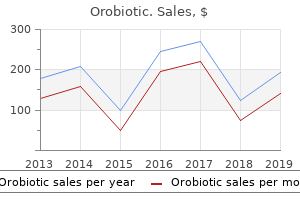
Buy generic orobiotic 250 mg on line
Medulloepithelioma may also be intraocular, arising from the ciliary body, and secondarily infiltrate the retina and optic nerve (see also Chapter 29). These may give rise to a range of lesions, including neoplasms and hamartomas, which should pose no problem with diagnosis when seen to be associated with teeth but can cause difficulty in other situations. One of the most popular classifications is by the macular growth phase characteristics. Grossly, the lung displays diffuse honeycombing in the absence of deposition of fibrous tissue between the cystic spaces. Kay S 1985 Microglandular adenosis of the female mammary gland: study of a case with ultrastructural observations. Histologically, a diffuse mononuclear infiltrate is present containing macrophages and multinucleate giant cells and T lymphocytes with convoluted nuclei. Compared with the low-grade component in the left field, cystic spaces constitute a less prominent component. Chondrosarcomas are graded as low-grade or high-grade lesions on the basis of the degree of cellularity, pleomorphism, multinucleated cells, and mitoses. Tubular apocrine adenoma521-525 is a range of small nodular tumors composed of tubules with apocrine features. Appelman H D, Oberman H A 1965 Squamous cell carcinoma of the larynx with sarcoma-like stroma. As a proportion of rhabdomyosarcomas as a whole, rhabdomyosarcomas in adults account for no more than 10%. Milroy C M, Rode J, Moss E 1991 Laryngeal paragangliomas and neuroendocrine carcinomas. Tumors designated nevoid melanoma or minimal deviation melanoma have not been studied extensively or systematically; most studies have been empiric and without significant follow-up. Sheets and cords of closely packed carcinoma cells invade into adjacent adipose tissue. The epithelium of the dental lamina is involved in the formation of enamel and maps out the shape of the tooth. Clinically, these cysts arise usually in the second through the fourth decades with an onset most often at or around puberty. The eccrine hidrocystomas507-509 are small, sometimes multiple (Robinson type) ductal cysts lined by simple epithelium. Otolaryngol Head Neck Surg 113: 157-161 152 Nasal Cavity, Paranasal Sinuses, and Nasopharynx 63. Chromosomal Abnormalities Other Than Chromosomal Translocations Although less frequent and generally less amenable to purely molecular diagnostic techniques, recurrent chromosomal abnormalities other than translocations contribute to the malignant phenotype of various tumors and can be useful diagnostic markers. The mainstay of treatment is complete surgical excision with or without postoperative radiotherapy. Wenig B M, Gnepp D R 1989 the spectrum of neuroendocrine carcinomas of the larynx. Histopathology and Immunohistochemistry the histologic hallmark of medulloepithelioma is mitotically active, pseudostratified columnar epithelium, often arranged in ribbons of tubules or papillary rosettes, with variable interposition of delicate stromal elements. Many authors have pointed out the difficulty in differentiating a low-grade chondrosarcoma from an enchondroma. It is common to find short strands of relatively acellular collagenous fibrous tissue or aggregates of foamy macrophages with scattered giant cells, indicative of microscopic fat necrosis. Immunoreactive cells can be scattered throughout the adenoma, but are often clustered. Page D L, Anderson T J, Sakamoto G 1987 Infiltrating carci noma: major histological types. These tumors are often misdiagnosed because pathologists are not accustomed to including them in the differential diagnosis of bone tumors. Histologically, pseudocarcinomatous hyperplasia is usually symmetric and has a range of growth patterns from mostly uniform hyperplastic infundibular structures to both infundibular and insular terminal duct squamatization to insular duct squamatization alone.
Diseases
- Coleman Randall syndrome
- Malignant mesenchymal tumor
- Rudd Klimek syndrome
- Tropical sprue
- Chromosome 16, trisomy 16p
- Ganser syndrome
- Metabolic acidosis
- Hunter syndrome
Cheap 100mg orobiotic visa
Histologically, the dilated and thin-walled vascular channels are lined by attenuated endothelial cells. Benign Epidermal Tumors and Tumor-like Conditions the epidermis has the capacity to develop an array of keratinocytic lesions, the causes of which are often unknown. The lymphoid infiltrate apparently begins in the periductal areas and gradually replaces the lobules. Am J Surg Pathol 33: 542-550 Janzer R C, Makek M 1983 Intraoral malignant melanotic schwannoma. Layfield L J 2009 Cytologic diagnosis of osseous lesions: a review with emphasis on the diagnosis of primary neoplasms of bone. The acinar-follicular spaces may be filled with inspissated material that simulates colloid. In problematic cases particularly in a core biopsy, myoepi thelial markers differentiate sclerosing adenosis from invasive tubular carcinoma. This is a rare form of breast tumor, usually presenting clinically as a mass lesion, often in the subperiareolar region. Clinically, atypical fibroxanthoma presents most often as a rapidly enlarging or exophytic polyp that is usually solitary and occurs in the head or neck region of older adults. The presence of occasional enlarged hyperchromatic or even bizarre nuclei among bland-looking cells, especially when not accompanied by mitotic figures, does not signify more aggressive behavior. Atrophy of nonneoplastic seromucinous glands in the radiated field often occurs, with enlargement of glandular epithelial nuclei. Because most cases are benign, this nomencla ture is misleading, as too is the designation "giant fibro adenoma" when some are undoubtedly malignant. Benign Melanocytic Lesions Melanocytic nevus is a biologically stable clinical macule, plaque, papule, or polyp that is prevalent in virtually 100% of light-skinned individuals and is almost always histologically symmetric, with increased numbers of melanocytes in the epidermis, dermis, or both. Burga A M, Tavassoli F A 2003 Periductal stromal tumor: a rare lesion with lowgrade sarcomatous behavior. Moosavi C, Jha P, Fanburg-Smith J C 2007 An update on plexiform fibrohistiocytic tumor and addition of 66 new cases from the Armed Forces Institute of Pathology, in honor of Franz M. Some require a cutoff of more than 30% of chondroid tissue for a diagnosis of chondroblastic osteosarcoma,158 a definition that is difficult to apply to needle biopsy tissue. Some lesions in particular have a potential for being confused as neoplasms because of their size or potential for recurrence. The spectrum, however, ranges from scant cellularity with abundant mucin to highly cellular tumors with minimal mucin, the cellular neurothekeomas,1317-1319 the cellular forms were once thought to be variants of follicular myxoma,1320 but with the discovery of mixed forms,1317 that is, myxoid and cellular patterns within the same lesion, the cellular forms in the past were thought perhaps to be part of the neurothekeoma spectrum. They are well circumscribed lobulated masses that may reach 15 to 20 cm in diameter, stretching the skin and distorting the nipple. Sections should be taken perpendicular to the limbus so that all margins of resection can be adequately sampled. Cytokeratin immunohistochemistry highlights the paranuclear fibrous body seen in sparsely granulated tumors. Hum Pathol 15: 526531 Rosen P P, Ernsberger D 1987 Low grade adenosquamous carci noma. They have the cystic-lobular growth pattern of their benign counterparts but are associated with pronounced cytologic pleomorphism, architectural disorganization, and infiltrative growth. Breast Cancer Res 12: R61 Pinder S E, ReisFilho J S 2007 Nonoperative breast pathology: columnar cell lesions. In essence, then, samples in which only one or two immunoglobulin/T-cell receptor sequences are detected are likely to be neoplastic, and samples in which multiple immunoglobulin/T-cell receptor sequences are detected are likely to be benign. Histologic artifacts, which can cause diagnostic confusion, also can be present in these lesions. Benign smooth muscle tumors arising from large, deep-seated blood vessels are almost nonexistent.
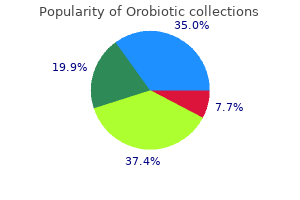
Discount orobiotic 250mg free shipping
It is possible to assess the sensitivity and specificity of an assay at different cutoff points giving an ability to choose differing thresh olds for different clinical situations. The epithelium consists of two layers-a luminal layer of oncocytic columnar cells supported by a discontinuous layer of oncocytic basal cells. Fine E D, Dahms B, Arnold J E 1995 Laryngeal hamartoma: a rare congenital abnormality. A, Some cells contain abundant basophilic granules, consistent with acinar cell differentiation. These pieces of evidence are now regarded widely as misjudged, and it is generally accepted that virtually none of the lesions in this category shows true histiocytic differentiation. Am J Surg Pathol 28: 1257-1267 Miettinen M, Enzinger F M 1999 Epithelioid variant of pleomorphic liposarcoma: a study of 12 cases of a distinctive variant of high grade liposarcoma. Typical hypocellular dermal lesion in which an epidermoid cyst (left) was also present. This variant of medulloblastoma appears to clinically behave more favorably than the classic medulloblastoma, making its recognition an important step in the treatment of medulloblastomas (see later discussion). In such instances, it may be difficult to distinguish neoplastic from inflammatory lymphoid infiltrates. A small subset of tumors remains that show a remarkable range of polyphenotypic differentiation, either morphologically or immunohistochemically. Ultrastructurally, these materials represent glycosaminoglycans and duplicated basal lamina. When any of these features are present, they often are evident throughout the lesion. Choi B H, Kim R C 1985 Expressions of glial fibrillary acidic protein by immature oligodendroglia and its implications. Anaplastic tumors may grow in densely cellular sheets, but the pseudorosette pattern is commonly maintained, especially in combination with microvascular hyperplasia. Bates A W, Baithun S I 1998 Atypical mixed tumor of the skin: histologic, immunohistochemical, and ultrastructural features in three cases and a review of the criteria for malignancy. Besides, there are now more specific means of identifying germline Rb mutations and ophthalmologists and oncologists should rely on these tests. The most primitive lesion, the trichoblastoma,300,308 consists only of basaloid germs that are devoid of stroma and mesenchymal induction. Malignant tumors under 2 cm are rare, but the majority measure between 2 and 5 cm. Malignant Peripheral Nerve Sheath Tumor Malignant peripheral nerve sheath tumor is an uncommon primary sarcoma of the lung (see Chapter 27). Am J Surg Pathol 24: 197202 Jimenez R E, Wallis T, Visscher D W 2001 Centrally necrotizing carcinomas of the breast: a distinct histologic subtype with aggres sive clinical behavior. The meningothelial proliferation is still easily identified surrounding the calcifications. The majority of tumors are cystic and show diverse gross appearances because of the presence of the different tissues and elements. It is helpful to realize that although squamous cell carcinomas do indeed develop in the eyelid, sebaceous carcinoma may be encountered more frequently in this location. Adamantinomatous craniopharyngioma is histologically characterized by stratified epithelium with a palisading arrangement of basal cells, intermixed with nodular strands of solid and cystic epithelium. Neurofibroma lacks Antoni A and B areas and perivascular hyalinization and is exceedingly rare at this site. A, the cribriform island (upper and left fields) shows deposits of abundant hyaline material, with "strangulation" of the tumor cells. Grossly, keratinizing papillomas are exophytic or papillary lesions with a white appearance and usually do not exceed 2 cm in greatest dimension. Sebaceous Neoplasms Sebaceous cells can normally occur in the parotid gland, submandibular gland, and oral minor salivary gland. The tumor is well circumscribed or thinly encapsulated and comprises an adenomatous proliferation accompanied by a dense lymphoid component. Histologically, these tumors are composed of a fascicular spindle cell proliferation replacing lung parenchyma. However, the dilated structures are lined by alveolar pneumocytes, some of which exhibit a hobnail appearance.
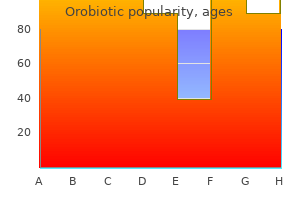
Buy orobiotic overnight delivery
By cytogenetic analysis, most schwannomas show either monosomy 22 or loss of 22q material. A background cellular infiltrate that includes smaller anaplastic cells is present. Survival correlates to some extent with tumor size, with lesions measuring less than 5 cm having a better prognosis. Sometimes the aneurysmal bone cyst-like changes are so prominent that the tumor may be only a mural nodule. Facial nerve palsy is uncommon, but fixation to underlying tissue or skin occurs in advanced cases. Later stage lesions contain increased numbers of centrocytes and fewer reactive T cells Nodular or diffuse infiltrates, composed of small lymphocytes, cells with lymphoplasmacytoid features, and plasma cells. The first is progression to highergrade epithelial-myoepithelial carcinoma, characterized by more solid growth, a greater degree of nuclear atypia, and frequent mitoses. More than 50% of patients eventually have metastases, most often to lymph nodes, lung, or bone, but this is commonly delayed over many years. An aggressive neoplasm derived from Schneiderian epithelium and distinct from olfactory neuroblastoma. Although most dedifferentiated chondrosarcomas arise from intramedullary, central chondrosarcoma, they also may occasionally originate from a preexisting osteochondroma (peripheral chondrosarcoma). Corticotroph adenomas showing extensive hyaline change (so-called Crooke cell adenoma) appear more often to be locally invasive and recurrent. The epithelioid fibrous histiocytoma1055-1059 is a notable variant with a peculiar epithelioid cytomorphology. Van Dam S D, Unni K K, Keller E E 2010 Metastasizing (malignant) ameloblastoma: review of a unique histopathologic entity and report of Mayo Clinic experience. Fractures may be superimposed on underlying osteoporosis, which typically occurs in postmenopausal women and involves the pelvic bones, especially the pubic rami and the sacral ala. If a commercial kit assay system is used, it is recommended that laboratories adhere strictly to the kit assay protocol and scoring meth odology. In parts of the world with a high incidence of oral cancer, such as India, most oral cancers arise in areas of leukoplakia. Pilomyxoid Astrocytoma One histopathologic variant, the pilomyxoid astrocytoma, warrants particular notice. Ki67 labeling index is low in the great majority of gangliogliomas, and it appears to be confined to the glial component. Pressure to the lesion results in the extrusion of white material, which is collections of molluscum bodies admixed with keratin. Conservative surgery with radiotherapy is increasingly used in the treatment of breast cancer, and it is estimated that about 0. Although the dysplastic cells are limited to the basal zone with maturation of the upper two thirds of the surface epithelium, the extent of architectural and cytomorphologic changes is diagnostic for severe dysplasia. The cells are typically arranged in patternless sheets but may form Homer Wright rosettes. Silver S A, Tavassoli F A 2000 Pleomorphic carcinoma of the breast: clinicopathological analysis of 26 cases of an unusual highgrade phenotype of ductal carcinoma. Although these lesions have been referred to as gliomas this may be a misnomer as they are not clearly neoplasms. Seifert G, Bull H G, Donath K 1980 Histologic subclassification of the cystadenolymphoma of the parotid gland. Kindblom L-G, Meis-Kindblom J M 1995 Chondroid lipoma: an ultrastructural and immunohistochemical analysis with further observations regarding its differentiation. Often these benign elements outnumber the cancer cells on a strict cell-by-cell counting basis. Tumor cells at the poorly differentiated (Ewing) end of the spectrum have scanty, pale cytoplasm and round to ovoid open nuclei with a very finely distributed ("dusty") chromatin pattern. Some osteosarcomas have massive amounts of matrix, and the nuclei of the tumor cells are inconspicuous. Clear-cut permeation of the tumor through the cortex into soft tissues supports a diagnosis of chondrosarcoma in a small bone.
Syndromes
- Sharp pain
- Throat pain - severe
- Dehydration
- The time it was swallowed
- Your hip pain has not gotten better with other treatments
- Hematoma (blood accumulating under the skin)
- High PT and PTT
- Chest x-ray
- Never add fresh breast milk to frozen milk.

Order orobiotic 250 mg without prescription
Primitive neuroectodermal tumor/Ewing sarcoma also has necrosis, with small cells showing hyperchromatic nuclei. The basaloid cells, in comparison with those seen in the cribriform and tubular patterns, usually exhibit more significant nuclear pleomorphism and mitotic activity. A small number of patients with osteosarcoma have involvement of multiple skeletal sites (multicentric osteosarcoma), either synchronous or metachronous, but without evidence of visceral metastases. However, the mixture of cell types such as epidermoid cells and goblet cells is not seen in salivary duct carcinoma. Currently it is generally agreed that only those mucosal lesions exhibiting significant dysplasia. Parham and associates555 subsequently proposed a simplified method for grading breast cancer by combining mitotic counts with tumor necrosis. B, Vascular polyp containing prominent vascular spaces and abundant fibrinous material. It is usually mononuclear, but eosinophils and neutrophils are seen occasionally, especially when the lesion is secondarily excoriated. Rehberg E, Kleinsasser O 1999 Malignant transformation in nonirradiated juvenile laryngeal papillomatosis. Those arising in central lesions of Ollier disease or Maffucci syndrome are termed central secondary chondrosarcoma. A, the tumor is surrounded by a fibrous capsule without evidence of invasion, as is characteristic of adenoma. When the cochlear division is involved the nerve is stretched rather than attached. They are accompanied by comparable hypertrophy of the myenteric plexus, or sometimes by ganglioneuromatosis, in the intestines. Nonspecific coexisting features may be present including epithelial hyperplasia, sclerosing ade nosis, cystic change, and apocrine metaplasia. Null cell adenomas demonstrate poorly differentiated cells with poorly developed organelles in association with only sparse small secretory granules. We find it helpful to start counting fields when at least one mitotic figure is seen and then move the slide and count in 10 consecutive nonoverlapping fields. This cellular field with limited calcified material is from a periapical cemental dysplasia. Walsh N, Ackerman A B 1990 Infundibulocystic basal cell carcinoma: a newly described variant. The secretory granules are often of different shapes (teardrop, spherical, heart shaped) and vary in electron density. Because oncocytosis can be pharmacologically induced in rats and these lesions may subsequently transform into oncocytoma,11 the various oncocytic lesions described previously could represent a spectrum of a single entity. Meta plastic carcinoma shows an infiltrative growth pattern and may be associated with an in situ carcinoma compo nent, or focal conventional ductal carcinomatous compo nent, in addition to often only focal cytokeratin and p63 expression in the metaplastic malignant cells, whereas myoid markers (smooth muscle actin and smooth muscle myosin heavy chain) are either negative or show only focal weak positivity. The tumor cells have a discrete nesting pattern, and many have distinct cytoplasmic argyrophilia. It has been stated that at least 5% to 10% of either component must be present to make this diagnosis. Mitotic activity is a major component for classifying this category, defined as 20 or more mitoses/10 hpf. In that study, increased mitotic activity did not appear to affect recurrence or survival. Epithelial-Myoepithelial Carcinoma Definition Epithelial-myoepithelial carcinoma is a malignant tumor composed of ductal structures lined by a single layer of ductal cells that are surrounded by a single or multiple layers of clear myoepithelial cells. Histologically, they have four principal components in varying relative proportions.
Cheap orobiotic 250 mg free shipping
Histopathology and Immunohistochemistry the morphologic features are intermediate between those of pineocytomas and pineoblastomas, with a particular tendency to show lobulated grouping of unipolar tumor cells demarcated by, and often aligned along, a delicate vascular stroma. The lesions are red to red-blue nodules on one, rarely both, legs Violet indurated patches and plaques on the lower legs or trunk Solitary or multiple purple to red-violet cutaneous or subcutaneous nodules with no specific site of occurrence B cell Nodular or diffuse infiltrates, usually sparing epidermis. Veness M J, Palme C E, Morgan G J 2006 High-risk cutaneous squamous cell carcinoma of the head and neck: results from 266 treated patients with metastatic lymph node disease. In fact, stromal hyaline material can be the first clue to the diagnosis of salivary gland type of tumor for neoplasms occurring outside the major salivary glands. The reactions occur within a closed reaction tube, eliminating the need for subsequent gel electrophoresis and reducing the opportunity for contamination. Most pleomorphic adenomas do not pose problems in diagnosis either, because of the presence of the characteristic chondromyxoid stroma. The lesion lacks cellular pleomorphism and is made up of homogeneous, pale-staining keratinocytes. When it involves the tendons, it tends to be localized and is referred to as giant cell tumor of tendon sheath (see Chapter 24). C, Tumor cells with moderate cellular atypia are disposed in a trabecular-festooning pattern and accompanied by myxoid matrix. Congenital Epulis (Synonym: Granular Cell Epulis) the congenital epulis is a rare but distinctive oral lesion of unknown etiology, found in the alveolus of neonates. Gemistocytic Astrocytoma Gemistocytic astrocytomas, the second most common variant, account for no more than 20% of astrocytomas. Tubular and cribriform patterns of pleomorphic cells containing eosinophilic cytoplasm. The distribution of goblet cells decreases over the bulbar conjunctiva-the component of the conjunctiva covering the eyeball-such that virtually no goblet cells are detected normally at the limbus, the junction between the cornea and sclera. The melanocytes usually have abundant eosinophilic cytoplasm that may appear to be syncytial on H&E stain. Sloane J P, Mayers M M 1993 Carcinoma and atypical hyperplasia in radial scars and complex sclerosing lesions: importance of lesion size and patient age. The cutoff points may appear to be rather arbitrary, but they are based on a pilot study that showed them to give the best prognostic separation in life table analysis. Palisaded Encapsulated Neuroma (Solitary Circumscribed Neuroma) the palisaded encapsulated neuroma1304-1311 is a small, flesh-colored tumor that usually occurs on the face of adults of either sex and much less often at other locations. From pure morphologic assessment of cribriform tumor islands, it is often impossible to tell which are intraductal (in situ) and which are invasive. However, medullary carcinomas usually lack fibrosis and gland formation and show a welldeveloped syncytial growth pattern (75% of tumor area), in addition to almost complete circumscription. This field alone is indistinguishable from basal cell adenoma or pleomorphic adenoma. Neoplasms are usually divided into benign and malignant, with very little room to accept intermediate biologic forms. The intervening stroma is scant and contains a moderate or severe lymphoplasmacytic infiltrate that does not intervene extensively between indi vidual tumor cells. A, the tubules are lined by ductal cells only, without an underlying layer of basal or myoepithelial cells. Retinal S-antigen immunoreactivity can be demonstrated in pineoblastomas, consistent with the photosensory lineage of the tumor cells. To gauge the full extent of the disease, ophthalmic surgeons may take small incisional biopsy samples in multiple locations on the surface of the conjunctiva ("map biopsies"), in addition to biopsies of the eyelid. Haque A K 1991 Pathology of carcinoma of the lung: an up-date on current concepts. The tumor may destroy the pituitary gland and produce evidence of pituitary dysfunction. Most present as a solitary palpable mass close to the nipple, although some lesions may be peripheral. Histologically, the most common pattern consists of lobules of squamous cells that form with abundant keratinization.
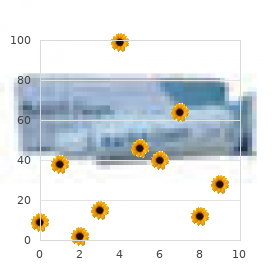
Discount orobiotic online master card
Histologically, they are unencapsulated and have papillary and glandular growth patterns. Rare tumors, usually of high grade, show remarkably epithelioid morphology, closely mimicking carcinoma or melanoma. Some authors have demonstrated unusually prominent nerve fibers adjacent to the nidus, perhaps accounting for the pain. Others have suggested the predominance of mucin secreting cells as a diagnostic feature. In these cases it is probably best to report the mixed patterns and advise that the behavior is likely to be determined by the most aggressive variant present. The histologic hallmark of xanthogranuloma is the diffuse, uniform population of mononuclear histiocytic cells admixed with Touton giant cells, eosinophils, and plasma cells, each of which may occur in varying proportions. Benign lesions in the differential diagnosis include bizarre parosteal osteochondromatous proliferation and subungual exostosis. The infiltrative edge, cellular ity of stroma, and relatively scanty epithelial component are all points in favor of a fibromatosis (see later discus sion). It is understood that a morphologic finding does not necessarily imply a biologically lethal outcome. This finding suggests orbital invasion by tumor, a characteristic that may trigger orbital exenteration. Parham and colleagues,554 in a relatively small morphometric study, found a strong cor relation between extensive necrosis and poor survival. Martuza R L, Eldridge R 1988 Neurofibromatosis 2 (bilateral acoustic neurofibromatosis). Sebaceous tumors are very rare neoplasms that are believed to arise from these sebaceous-differentiated cells. Two recent studies suggest that high microvascular density may be an independent marker of metastatic behavior. Histologically, the lesions are poorly circumscribed and range from cellular to myxoid in a dense to loose collagenous matrix. Most cases of solitary schwannoma are asymptomatic, and the majority are less than 5 cm in diameter. Collagenous spherulosis is more often seen in intraductal papillomas and hyperplasia than in in situ carcinomas. These tumors are exophytic, papillary, nodular, or cauliflower-like with a soft to gritty consistency, measuring from a few millimeters to 4. In cases where either tumor heterogeneity is seen (1%2% of cases) or the ratio is close to 2. The normal cell phenotype giving rise to the silent corticotroph adenoma has yet to be established. In long-standing cases these foci may be replaced by more obviously cartilaginous tissue. The cytoplasm of the tumor cells often shows long dendritic prolongations that are best appreciated with the use of special stains or electron microscopy. Cao D, Srodon M, Montgomery E A, Kurman R J 2005 Lipomatous variant of angiomyofibroblastoma: report of two cases and review of the literature. Patients with pineoblastomas have a short overall survival time (16 months in a large cohort study)416 and low 5-year progression-free survival (38% in one series). Frozen section analysis at the time of surgery can be helpful in determining if the specimen contains diagnostic tissue before the wound is closed. It had long been realized that the tumors with a very obvious alveolar architecture behaved in an aggressive manner but, importantly, it has also been appreciated464,465 that tumors that appear to have a solid, embryonal-type of growth pattern. Immunohistochemistry is essential in confirming the diagnosis and in differentiating a malignant lymphoma from carcinoma. In axial tumors, osseous involvement frequently occurs, and it is impossible to determine with certainty whether primary origin was in bone or soft tissue.
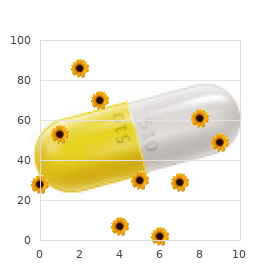
Order orobiotic 250 mg on-line
Staining with p63 may vary from diffuse and strong to focal scattered moderately to strongly positive nuclei. Some cases may have mixed patterns, including those with features of large cell lymphoma. Counting of apoptotic index can be performed on H&E sections in the same way as the mitotic index or can be carried out by using immunocytochemical markers. This is reflected in a recent large study reporting 5- and 10-year local recurrent rates of 48% and 67%, respectively. Approximately 2% of cases contain aggregates of mature adipocytes, which appear to represent a form of degenerative metaplasia. House J W, Wilkinson E P 2008 External auditory exostoses: evaluation and treatment. Additionally, the perifollicular fibrous sheath is prominent in some of these tumors. B, Cytokeratin immunostain highlights Crooke changes on normal corticotroph cells in pituitary gland adjacent to an adrenocorticotropic hormone adenoma. Histologically, the tumor invades the surrounding parenchyma in broad fronts, resulting in multiple tumor nodules separated by sclerotic stroma. Cytologically, the lesion is similar to spindle squamous carcinoma and atypical fibroxanthoma. Pathologic Findings Tumors are frequently removed piecemeal but in situ are generally polypoid, involving the posterior canal. In this tumor, other minor areas showing typical histologic features of pleomorphic adenoma were also present (not shown). Provided the diagnosis is correct, the lesion will not metastasize even if it is incompletely excised. Myxofibrosarcoma affects mainly adults in the sixth to eighth decades, although the overall age range is wide. It has been suggested that recurrence is more frequent for stroma-rich tumor, which has a higher chance of spillage of mucoid stroma during operation. Eberhart C G, Wiestler O D, Eng C 2007 Cowden disease and dysplastic gangliocytoma of the cerebellum/Lhermitte-Duclos disease. Sclerosing Lymphocytic Lobulitis Sclerosing lymphocytic lobulitis, also known as lym phocytic mastopathy, is a recently recognized inflamma tory disorder of the breast. Most lesions are recalcitrant to therapy, but limited success has been achieved with carbon dioxide laser416 and retinoic acid. This appearance can simulate persistent small islands of carcinoma to the unwary observer. Because a pulmonary mass may occasionally represent the initial manifestation of a mediastinal thymoma, it is imperative that a mediastinal tumor be ruled out by appropriate imaging studies before rendering a diagnosis of primary thymoma of the lung. The plump, often lipidized, stromal cells with round nuclei are admixed with more fusiform endothelial cells. Histologically, the tumors are quite different from pulmonary blastoma of the adult (see p 221) in that an immature epithelial component is not part of the lesion. The hormonal production from these tumors is inefficient, and detection of excess hormone levels is challenging. Rawlinson D G, Herman M M, Rubinstein L J 1973 the fine structure of a myxopapillary ependymoma of the filum terminale. Tavassoli F A, Norris H J 1994 Intraductal apocrine carcinoma: a clinicopathologic study of 37 cases. Kim S H, Kim H, Kim T S 2005 Clinical, histological, and immunohistochemical features predicting 1p/19q loss of heterozygosity in oligodendroglial tumors. The stroma takes the form of a mixture of chondroid (hyaline cartilage), myxoid, chondromyxoid, hyaline, and, very rarely, osseous and adipose tissues.
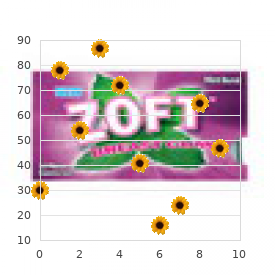
Order 500mg orobiotic overnight delivery
In the majority of cases local marginal excision is adequate and any microscopic residual lesional tissue undergoes spontaneous attrition, generally seeming to leave little or no scar. Furthermore, patients with thyroid medullary thyroid carcinoma have elevated serum calcitonin level, a finding not associated with atypical carcinoid. Waldeyer ring lymphomas account for approximately 50% of all extranodal non-Hodgkin malignant lymphoma in the head and neck, where the incidence of extranodal non-Hodgkin lymphomas is second only to that in the gastrointestinal tract. It is lined by stratified squamous epithelium that matures through a granular zone and contains laminated keratin and numerous hairs within the cyst cavity. The tumor cells may assume cuboidal, columnar, spindled, or polygonal shapes, but the bland cytologic features are always maintained. Cancer 70: 2099-2104 Wright J D, Font R L 1979 Mucinous sweat gland adenocarcinoma of eyelid: a clinicopathologic study of 21 cases with histochemical and electron microscopic observations. The most common symptoms include hoarseness and a neck mass, less often sore throat, dysphagia, hemoptysis, and otalgia. Some studies have abandoned the rigid classification scheme outlined in Table 29-6 and record only the presence or absence of any epithelioid cells. The cellular processes, visible on hematoxylin and eosin staining, form either long, tapering, fibrillary processes or a dense Gross Appearance and Radiologic Features Ependymomas are relatively well-demarcated tumors with macroscopically "pushing borders" compared with other gliomas. They arise from rests of dental lamina, but the alternative name "primordial cyst" was derived from the erroneous concept that this cyst arises by degeneration of a tooth germ before calcified tissue has formed. Basosquamous-metatypical: Prominent squamous differentiation, with less peripheral palisading. Fisher C, Miettinen M 1997 Parachordoma: a clinicopathologic and immunohistochemical study of four cases of an unusual soft tissue neoplasm. Metaplastic (carcinosarcomatous) variants contain unusual homologous (spindle cell) and heterologous (distinct sarcomatous) components but may not be associated with a poor prognosis. Laryngeal papillomas have traditionally been divided into juvenile and adult types, but the multiple recurring papillomas, whether presenting in childhood or adulthood, are now generally considered to represent the same basic entity,7,8 although childhood cases tend clinically to be more aggressive than those occurring initially in adults. Sometimes the basaloid cells appear plump and spindled, streaming in the longitudinal direction of the tumor islands. The main mass of the lesion is a nonencapsulated area of very cellular connective tissue. The infiltrate typically effaces the epidermis, often resulting in necrosis or ulceration. The tumors show a combination of solid (dedifferenti ated), microcystic, and microglandular areas. Keratocysts may envelop an unerupted tooth and appear dentigerous on a radiograph or may occasionally replace a tooth. Lining these spaces or in adjacent clusters are small, round epithelioid meningothelial cells. Many ophthalmologists who resect conjunctival malignancies with narrow margins resort to adjunctive nonsurgical therapies. The concept that primitive progenitors and differentiated cell populations, as oncogenic targets, have a differential susceptibility for specific genetic and epigenetic events in the process of neoplastic transformation and subsequent tumorigenesis will have a future impact on glioma classification. Differential diagnosis from adenocarcinoma is accomplished by recognizing the acantholytic nature of the process creating the spaces and by lack of mucin positivity in tumor cells. These are bizarre-appearing cells with enlarged, pleomorphic and hyperchromatic nuclei, indistinct to prominent nucleoli, and eosinophilic to basophilic cytoplasm. It is possible that many of the cases presented in the literature as belonging to this group of tumors may, in fact, have been carcinosarcomas. Lipomatosis of Nerve (Fibrolipomatous Hamartoma; Neural Fibrolipoma) Lipomatosis of nerve is a rare condition that, although it has been the subject of many single case reports, has only once been documented properly in a large series. Fortunately, few, if any, intraocular processes can be confused with retinoblastoma histologically. This can be obviated by making an initial decision to reduce the available options to two. It is significant that, at this better differentiated end of the morphologic continuum. The tumor cells typically have a well-defined polygonal appearance with conspicuous cytoplasm and oval to round nuclei with inconspicuous nucleoli. Mesotheliomas only rarely give rise to clinically detected metastases (although, because of the increasing incidence, such cases are becoming more frequent), and most often they spread locally within the thoracic cavity. Papillary Analysis of the tumor cells covering the papillae is helpful in diagnosis.

